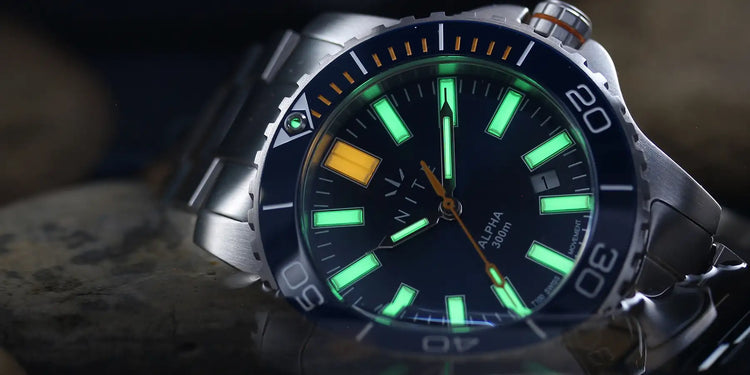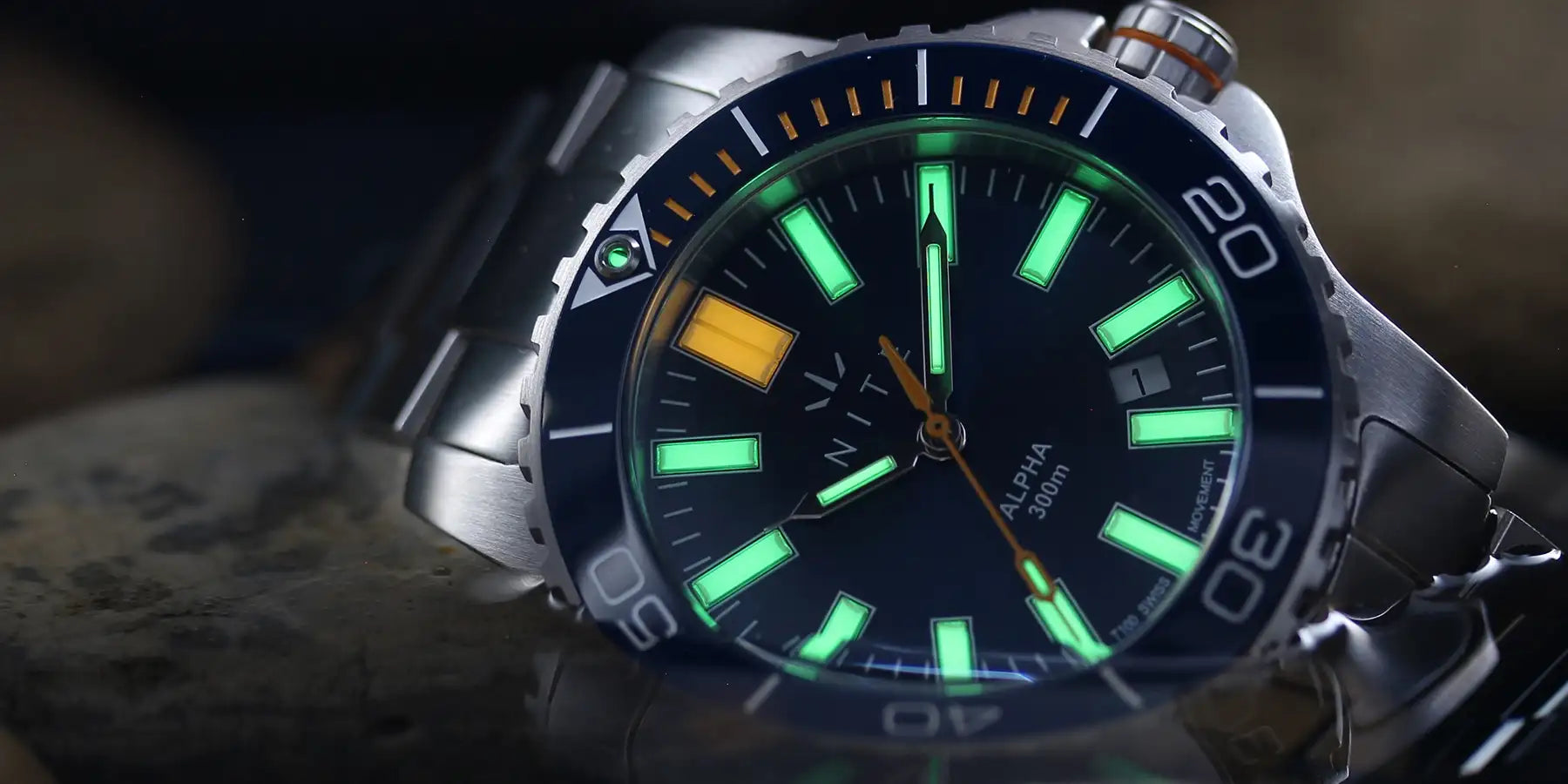Key Takeaways
- Tritium provides constant 24/7 glow for up to 20 years without charging
- Traditional lume requires light charging and fades within hours
- Professional users choose tritium for mission critical reliability
- T25 and T100 ratings determine tritium brightness levels
- Tritium costs more initially but provides decades of performance
- Traditional lume suits casual users who can maintain charging routines
The Clear Winner for Better Illumination
When choosing between tritium and traditional lume illumination, the answer to "which glows better" depends on what you mean by "better." If you need consistent, reliable glow that works around the clock without intervention, tritium wins decisively. Traditional lume can appear brighter initially, but only after charging and only for a limited time.
We've been building tritium watches for military professionals and adventurers for over two decades. From our experience, tritium's constant glow is the difference between having gear you can rely on and having something that might let you down when it counts.
Superior Glow: What Makes Tritium Better

Tritium works completely differently from normal glow paint, and that's what makes it better for serious watch users. Think of it like having tiny glass tubes filled with gas that creates its own light. These tubes glow constantly, day and night, for up to 20 years without ever needing to be "charged" under a light.
There's no charging period, no fading overnight, and you never need to worry about whether your watch will glow when you need it. This reliability is exactly why UK Special Forces chose our MX10: when you're operating in the dark, you can't afford to have a watch that might not be visible. Come to think of it, that's precisely why we say it's "forged in the field, proven by professionals."
We source our tritium from Switzerland's mb-microtec, the company that supplies military forces worldwide. Swiss manufacturing means consistent quality and reliable performance that lasts up to 20 years. Tritium is completely safe: the tubes are sealed and the radiation can't penetrate your skin. We should clarify that this isn't some new technology we're experimenting with; it's been battle tested for decades.
How Traditional lume Works
Traditional lume is glow-in-the-dark paint that needs to absorb light before it can glow. You charge it by exposing your watch to light, then it glows for a while before fading away. When freshly charged, it can look incredibly bright - often brighter than tritium for the first hour.
But it fades fast. Traditional lume is brightest right after charging, then drops off quickly. After 4-6 hours in the dark, most watches become hard to read clearly. This inconsistent brightness is why it doesn't glow better than tritium for practical use.
The charging requirement creates problems if you actually need to see your watch in the dark. If your watch has been in a drawer, under your sleeve, or indoors all day, the glow might not be bright enough when you need it.
Why Professionals Choose Tritium

When your safety depends on reading your watch clearly, you can't mess about with illumination that might not work. Military personnel, emergency responders, serious divers, and expedition leaders all choose tritium for the same reason: it's there when you need it, every single time.
Picture this: you're six hours into a night dive or responding to an emergency call at 3 AM. Your watch has been in darkness for hours. With traditional lume, you're squinting at a dim glow that's barely readable. With tritium, it's as bright and clear as when you first put the watch on.
Whether you're climbing mountains, diving reefs, or working night shifts, extreme conditions reveal why tritium beats traditional lume. From arctic expeditions to desert adventures, tritium keeps glowing regardless of what you throw at it. The reality is, when every second counts, you need to trust what's on your wrist, and that's exactly why we've built our reputation on gear that never quits.
Understanding Tritium Brightness: T25 vs T100
Tritium brightness is measured in T25 and T100 ratings. T25 gives you controlled brightness that's perfect when you need to stay discreet, ideal for tactical situations. Our MX10 series uses T25 tritium for this exact reason.
T100 delivers maximum brightness for when visibility is everything. Our Hawk series features T100 tritium because clear visibility in poor field conditions can be a matter of safety. Both ratings keep their brightness for up to 20 years, no gradual dimming like you get with other illumination types.
Fundamentally, both specifications represent engineered to endure performance that's been field tested by professionals who can't afford equipment failure.
Which Glows Better: The Real Comparison
Here's the honest comparison: Traditional lume wins for the first hour after a good charge. It can be genuinely impressive, brighter than tritium by a significant margin. But that's only if you've charged it properly and only for a short window.
Tritium delivers consistent brightness whether you check your watch at midnight or 6 AM, whether it's been in your kit bag for days or sitting in bright sunlight. That consistency is what makes tritium glow better for practical use.
We've had feedback from users in everything from polar expeditions to desert crossings. The story is always the same: tritium just works. Traditional lume watches start strong but become unreliable as charging opportunities disappear. In practice, this consistency is what separates purpose built equipment from consumer accessories.
When Traditional Lume Makes Sense
Traditional lume works for casual wearers who like dramatic initial brightness and can maintain charging routines. It's cheaper to manufacture, bringing watch prices down. Collectors often love the spectacular glow you get right after charging.
But understand the limitations: you need to maintain charging routines, accept reduced visibility during dark periods, and know that performance drops off over time. For many people, these compromises aren't worth the cost savings.
Actually, we'd be doing you a disservice if we didn't mention that some people genuinely prefer the charging ritual and the dramatic brightness peak. It's just not what we'd recommend when reliability matters more than spectacle.
Cost vs Long-Term Value
Yes, tritium costs more upfront due to precision manufacturing and safety compliance. But twenty years of consistent performance without maintenance represents serious value. Think about cost per year of reliable service: tritium wins easily.
Quality tritium watches also hold their value better due to proven performance and military heritage. Professional users often calculate this as cost per operational hour, where tritium demonstrates clear superiority.
Operationally speaking, we've found that people who need their equipment to work don't think twice about the initial cost difference once they understand the reliability factor.
Making the Right Choice
The choice comes down to your priorities. Need guaranteed visibility during extended periods without light? Choose tritium. Want impressive initial brightness for casual use? Traditional lume might work.
Ask yourself: Do you need reliable illumination when your safety depends on it? Will your watch spend time in dark environments before critical use? Are you willing to pay more for decades of worry free performance?
If you answered yes, tritium is the clear choice. For a deeper dive into tritium technology and its applications, we've got you covered with comprehensive guides.
NITE's complete range of tritium watches offers proven solutions built for those who demand reliability. From the original MX10 field watch to the Alpha dive collection, each delivers consistent tritium performance where it matters most. Ready to experience illumination that never lets you down? Explore NITE's tritium collection and discover why professionals worldwide trust our watches when failure isn't an option, because that's what being "purpose built, field tested, adventure ready" really means.
Frequently Asked Questions
Which illumination lasts longer? Tritium maintains consistent brightness for up to 20 years without charging. Traditional lume requires regular light exposure and may degrade over time.
Is tritium safe to wear? Yes, tritium tubes are completely safe. The sealed construction prevents gas leakage, and radiation cannot penetrate skin. Tritium watches meet all international safety standards.
How bright is tritium compared to Traditional lume? Traditional lume can appear brighter immediately after charging, but tritium provides superior average brightness over extended periods. Tritium maintains consistent output whilst traditional lume fades predictably.
Why do professionals prefer tritium? Professionals choose tritium for reliability and consistency. Military personnel, emergency responders, and divers need illumination that works without user intervention, especially during extended operations.
What's the difference between T25 and T100 tritium? T25 provides controlled brightness ideal for tactical applications. T100 offers maximum brightness for optimal visibility. Both maintain consistent output throughout their operational lifespan.
Do tritium watches cost more? Tritium watches have higher initial costs due to precision manufacturing. However, the 20 year lifespan and consistent performance often provide better value over time for professional applications.












